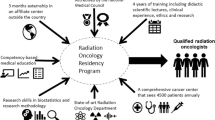Abstract
Background
Pediatric residents exhibit knowledge gaps in appropriateness of imaging utilization.
Objective
This study evaluates the value of radiologist-driven imaging education in a pediatric residency program. The primary goals of this educational program were to provide pediatric residents with resources such as the American College of Radiology Appropriateness Criteria, support optimal resource utilization and patient care, increase resident understanding of radiation risk, and determine the value of integrating radiologists into pediatric education.
Materials and methods
A needs assessment was performed in which the chief residents of a large pediatric program were surveyed. The consensus of chief residents was that a four-part lecture series delivered by a pediatric radiology fellow would be beneficial to the pediatric residents. Topics included general radiation risk as well as basic imaging topics in the chest, abdomen, neurological system, extremities and vasculature. Each lecture integrated appropriate ordering, ALARA (As Low As Reasonably Achievable)/Image Gently, and basic image interpretation. Residents were asked, using a Likert scale, to rate their understanding of radiation risk, the ACR Appropriateness Criteria, and other topics of interest before and after each lecture. Pediatric residents were given a 10-item quiz before and after the lecture series to assess their knowledge regarding the best test to order in clinical scenarios.
Results
The average pre-lecture score for knowledge of radiation risk was 3.27 (95% confidence interval [CI]: 3.02–3.51) out of 5, which improved to 4.27 (95% CI: 4.09–4.57) post-lecture. There was an increase in understanding of ACR appropriateness, with pre-lecture rating of knowledge increasing from 1.91 (95% CI 1.54–2.29) out of 5 to 3.61 (95% CI 3.33–3.90) post-lecture. The residents averaged 82.7% (95% CI 77.3%–88.1%) on the appropriateness pre-test and 93.8% (95% CI 90.3%–97.2%) on the post-test. Residents provided positive feedback upon conclusion of the program and reported a beneficial effect on their education.
Conclusion
A radiologist-driven lecture series in a pediatric residency can improve resident understanding of appropriate ordering practices and radiation risk. Radiologist participation in pediatric residency training is well-received.
Similar content being viewed by others
References
Levin DC, Rao VM (2013) The declining radiology job market: how should radiologists respond? J Am Coll Radiol 10:231–233
Prezzia C, Vorona G, Greenspan R (2013) Fourth-year medical student opinions and basic knowledge regarding the field of radiology. Acad Radiol 20:272–283
Vijayasarathi A, Hawkins CM, Hughes DR et al (2015) How much do common imaging studies cost? A nationwide survey of radiology trainees. AJR Am J Roentgenol 205:929–935
Retrouvey M, Trace AP, Shaves S (2016) Radiologic knowledge and ordering habits of clinical residents: ACR appropriateness criteria awareness and perceptions. J Am Coll Radiol 13:725–729
Gunderman RB, Bettmann M, Davis LP (2007) Promoting educational innovation: lessons from the request for proposals for ACR appropriateness criteria usage in medical education. J Am Coll Radiol 4:919–924
Pfeifer CM (2019) The value of radiology resident participation in internal medicine morbidity and mortality conferences at a small center of graduate medical education. Curr Prob Diag Radiol 48:305–307
Gispen FE, Magid D (2016) Assessing medical student knowledge of imaging modality selection before and after a general radiology elective: a comparison of MS-IIs, MS-IIIs, and MS-IVs. Acad Radiol 23:643–650
Leschied JR, Knoepp US, Hoff CN et al (2013) Emergency radiology elective improves second-year medical students’ perceived confidence and knowledge of appropriate imaging utilization. Acad Radiol 20:1168–1176
Collins J, Riebe JD, Albanese MA et al (1999) Medical students and radiology residents: can they learn as effectively with the same educational materials? Acad Radiol 6:691–695
Dillon JE, Slanetz PJ (2010) Teaching evidence-based imaging in the radiology clerkship using the ACR appropriateness criteria. Acad Radiol 17:912–916
Straus CM, Webb EM, Kondo KL et al (2014) Medical student radiology education: summary and recommendations from a national survey of medical school and radiology department leadership. J Am Coll Radiol 11:606–610
Schiller PT, Phillips AW, Straus CM (2018) Radiology education in medical school and residency. the views and needs of program directors Acad Radiol 25:1333–1343
The Pediatric Radiology Milestone Project. A Joint Initiative of The Accreditation Council for Graduate Medical Education and The American Board of Radiology. July 2015. Available at: https://www.acgme.org/Portals/0/PDFs/Milestones/PediatricRadiologyMilestones.pdf Accessed 1 June 2018
Acknowledgments
This paper was awarded the Outstanding Clinical Education Paper by the American Academy of Pediatrics Section on Radiology at the 2019 Society of Pediatric Radiology Meeting in San Francisco, California.
Author information
Authors and Affiliations
Corresponding author
Ethics declarations
Conflicts of interest
None
Additional information
Publisher’s note
Springer Nature remains neutral with regard to jurisdictional claims in published maps and institutional affiliations.
Rights and permissions
About this article
Cite this article
Pfeifer, C.M., Castillo, S.M. Pediatric radiologist-driven didactics for a pediatric residency program: a quality initiative. Pediatr Radiol 50, 397–400 (2020). https://doi.org/10.1007/s00247-019-04559-2
Received:
Revised:
Accepted:
Published:
Issue Date:
DOI: https://doi.org/10.1007/s00247-019-04559-2




